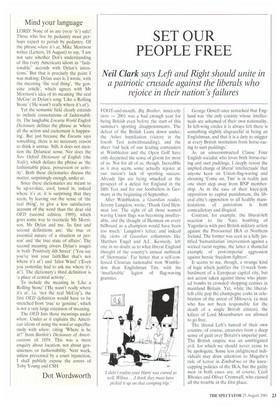Mind your language
LORD! None of us are (recte 'is') safe! Those who live by pedantry must perhaps expect to perish by pedantry. Of the phrase where it's at, Mike Morrison writes (Letters, 18 August) to say, 'I am not sure whether Dot's understanding of this (very American) idiom as "fashionable" accords with Dylan's intentions.' But that is precisely the point I was making; Dylan uses it, I wrote, with the meaning the real thing', 'the genuine article', which agrees with Mr Morrison's idea of its meaning 'the real McCoy' in Dylan's song 'Like a Rolling Stone' (He wasn't really where it's at').
Yet the semantic field clearly extends to include connotations of fashionability. The laughable Encarta World English Dictionary defines the phrase as 'where all the action and excitement is happening'. But just because the Encarta says something, there is no necessary reason to think it untrue. Still, it does not mention the Dylanical sense. Nor does the New Oxford Dictionary of English (the Node), which defines the phrase as 'the fashionable place, possession or activity'. Both these dictionaries discuss the matter, surprisingly enough, under at.
Since these dictionaries are meant to be up-to-date, cool, tuned in, indeed where it's at, it is surprising that they seem, by leaving out the sense of 'the real thing', to give a less satisfactory account of the word than the dear old OED (second edition, 1989), which goes some way to reconcile Mr Morrison, Mr Dylan and me. Its first and second definitions are: 'the true or essential nature of a situation or person' and 'the true state of affairs'. The second meaning covers Dylan's usages in both 'Positively 4th Street' (You say you've lost your faith/But that's not where it's at') and 'Idiot Wind' (`Even you yesterday had to ask me where it's at'). The dictionary's third definition is 'a place of central activity'.
To include the meaning in 'Like a Rolling Stone' ('He wasn't really where it's at', i.e. 'not the real McCoy'), the first OED definition would have to be stretched from 'true' to 'genuine', which is not a very large extension of meaning.
The OED lists those meanings under where. Under at it explains the American idiom of using the word at superfluously with where, citing 'Where is he at?' from Bartlett's Dictionary of Americanisms of 1859. This was a mere enquiry about location, not about genuineness or fashionability. Next week, unless prevented by a court injunction, I shall publicly expose the errors of Toby Young and CSH,
Dot Wordsworth


























































 Previous page
Previous page